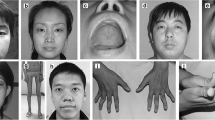Abstract
Autosomal-dominant centronuclear myopathy (CNM) due to mutations in the dynamin 2 gene (DNM2) is a rare congenital myopathy histopathologically characterized by centrally located nuclei and a radial arrangement of sarcoplasmic strands around the central nuclei. A total of 1,582 consecutive muscle biopsies of adult patients (age ≥18 years) were screened for morphologically characteristic signs of CNM. Patients with CNM were screened for mutations in DNM2. Clinical data and complementary neurophysiologic, respiratory, cardiac, and muscle MRI data in these patients were analyzed. Six index patients had histopathological signs of CNM (0.38%). Three had the heterozygous p.R465W and 2 siblings the heterozygous p.E368K DNM2 mutation. In 2 patients mutational screening for DNM2, BIN1, MTM1, and RYR1 was negative. Apart from the siblings, there was no positive history, parental mutation screening in 2 cases was negative. Both the percentage of muscle fibers with centralized nuclei and the ratio of muscle fibers with centralized to internalized nuclei were higher in DNM2-CNM compared to non-DNM2-CNM (50% vs. 18% and 94% vs. 63%). The onset was already neonatal or in infancy in 3/5 patients with DNM2 mutation. Symptoms in DNM2-CNM included bilateral ptosis (n = 3), paresis of the external ocular muscles (n = 2), axonal neuropathy (n = 4), restrictive ventilatory involvement (n = 5), and contractures (n = 5), including muscular torticollis (n = 1) and masticatory muscles (n = 2). DNM2-CNM patients and non-DNM2-CNM patients could not be distinguished by clinical features. DNM2-CNM often shows de novo mutations. In addition to the feature of radial sarcoplasmic strands, the ratio of centrally to internalized nuclei might help to differentiate DNM2-CNM from other forms of CNM. Other genes than currently known seem to cause the clinical and histopathological phenotype of CNM.

Similar content being viewed by others
References
Bitoun M, Maugenre S, Jeannet PY et al (2005) Mutations in dynamin 2 cause dominant centronuclear myopathy. Nat Genet 37:1207–1209
Bitoun M, Bevilacqua JA, Prudhon B et al (2007) Dynamin 2 mutations cause sporadic centronuclear myopathy with neonatal onset. Ann Neurol 62:666–670
Bitoun M, Stojkovic T, Prudhon B et al (2008) A novel mutation in the dynamin 2 gene in a Charcot-Marie-Tooth type 2 patient: clinical and pathological findings. Neuromuscul Dis 18:334–338
Bitoun M, Bevilacqua JA, Eymard B et al (2009) A new centronuclear myopathy phenotype due to a novel dynamin 2 mutation. Neurology 72:93–95
Dubowitz V, Sewry CA (2007) Muscle Biopsy. A practical approach. Elsevier, Amsterdam
Fabrizi GM, Ferrarini M, Cavallaro T et al (2007) Two novel mutations in dynamin 2 cause axonal Charcot-Marie-Tooth disease. Neurology 69:291–295
Fischer D, Herasse M, Bitoun M et al (2006) Characterization of the muscle involvement in dynamin 2-related centronuclear myopathy. Brain 129:69–1463
Jeub M, Bitoun M, Guicheney P et al (2008) Dynamin 2-related centronuclear myopathy: clinical, histological and genetic aspects of further patients and review of the literature. Clin Neuropathol 27:430–438
Jungbluth H, Wallgren-Pettersson C, Laporte J (2008) Centronuclear (myotubular) myopathy. Orphanet J Rare Dis 3:26
Jungbluth H, Wallgren-Pettersson C, Laporte JF et al (2009) 164th ENMC International workshop: 6th workshop on centronuclear (myotubular) myopathies, 16–18th January 2009, Naarden, The Netherlands. Neuromuscul Dis 19:721–729
Jungbluth H, Cullup T, Lillis S et al (2009) Centronuclear myopathy with cataracts due to a novel dynamin 2 (DNM2) mutation. Neuromuscul Dis 20:49–52
Melberg A, Kretz C, Kalimo H et al (2009) Adult course in dynamin 2 dominant centronuclear myopathy with neonatal onset. Neuromuscul Dis 20:6–53
Nicot AS, Toussaint A, Tosch V et al (2007) Mutations in amphiphysin 2 (BIN1) disrupt interaction with dynamin 2 and cause autosomal recessive centronuclear myopathy. Nat Genet 39:9–1134
Romero NB (2009) Centronuclear myopathies: a widening concept. Neuromuscul Disord 20:223–228
Susman RD, Quijano-Roy S, Yang N et al (2010) Expanding the clinical, pathological and MRI phenotype of DNM2-related centronuclear myopathy. Neuromuscul Disord 20:229–237
Zanoteli E, Vergani N, Campos Y (2009) Mitochondiral alterations in dynamin 2-related centronuclear myopathy. Arq Neuro-Psiquiatr 67:4–102
Conflict of interest
None.
Author information
Authors and Affiliations
Corresponding author
Rights and permissions
About this article
Cite this article
Hanisch, F., Müller, T., Dietz, A. et al. Phenotype variability and histopathological findings in centronuclear myopathy due to DNM2 mutations. J Neurol 258, 1085–1090 (2011). https://doi.org/10.1007/s00415-010-5889-5
Received:
Revised:
Accepted:
Published:
Issue Date:
DOI: https://doi.org/10.1007/s00415-010-5889-5




